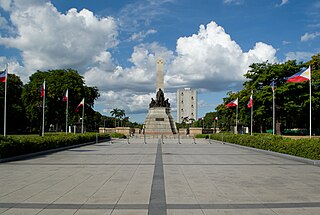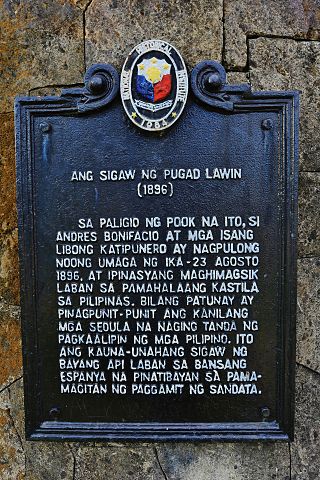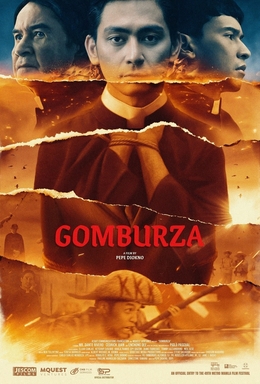
José Apolonio Burgos y García was a Filipino Catholic priest, accused of mutiny by the Spanish colonial authorities in the Philippines in the 19th century. He was tried and executed in Manila along with two other clergymen, Mariano Gomez and Jacinto Zamora, who are collectively known as the Gomburza.

Gomburza, alternatively stylized as GOMBURZA or GomBurZa, refers to three Filipino Catholic priests, Mariano Gómes, José Burgos, and Jacinto Zamora, who were executed by a garrote on February 17, 1872, in Bagumbayan, Philippines by Spanish colonial authorities on charges of subversion arising from the 1872 Cavite mutiny. The name is a portmanteau of the priests' surnames.

The Archdiocese of Manila is the archdiocese of the Latin Church of the Catholic Church in Metro Manila, Philippines, encompassing the cities of Manila, Makati, San Juan, Mandaluyong, Pasay, Taguig, and Quezon City. Its cathedral is the Minor Basilica and Metropolitan Cathedral of the Immaculate Conception, also known as the Manila Cathedral, located in Intramuros, which comprises the old city of Manila. The Blessed Virgin Mary, under the title Immaculate Conception, is the principal patroness of the archdiocese.

Rizal Park, also known as Luneta Park or simply Luneta, is a historic urban park located in Ermita, Manila. It is considered one of the largest urban parks in the Philippines, covering an area of 58 hectares. The site on where the park is situated was originally known as Bagumbayan during the Spanish colonial period. It is adjacent to the historic Walled City of Intramuros.
Capital punishment in the Philippines specifically, the death penalty, as a form of state-sponsored repression, was introduced and widely practiced by the Spanish government in the Philippines. A substantial number of Filipino national martyrs like Mariano Gómez, José Burgos, and Jacinto Zamora, Thirteen Martyrs of Cavite, Thirteen Martyrs of Bagumbayan, Fifteen Martyrs of Bicol, Nineteen Martyrs of Aklan and Jose Rizal were executed by the Spanish government.

The Order of Augustinian Recollects (OAR) is a mendicant Catholic religious order of friars and nuns. It is a reformist offshoot from the Augustinian hermit friars and follows the same Rule of St. Augustine. They have also been known as the "Discalced Augustinians".

The Cavite mutiny was an uprising of Filipino military personnel of Fort San Felipe, the Spanish arsenal in Cavite, Philippine Islands on January 20, 1872. Around 200 locally recruited colonial troops and laborers rose up in the belief that it would elevate to a national uprising. The mutiny was unsuccessful, and government soldiers executed many of the participants and began to crack down on a burgeoning Philippines nationalist movement. Many scholars believed that the Cavite mutiny was the beginning of Filipino nationalism that would eventually lead to the Philippine Revolution.

Jacinto Zamora y del Rosario was a Filipino Catholic priest, part of the Gomburza, a trio of priests who were falsely accused of mutiny by the Spanish colonial authorities in the Philippines in the 19th century.

Mariano Gómes de los Ángeles, often known by his birth name Mariano Gómez y Custodio or Mariano Gomez in modern orthography, was a Filipino Catholic priest who was falsely accused of mutiny by the Spanish colonial authorities in the Philippines in the 19th century. He was placed in a mock trial and summarily executed in Manila along with two other clergymen collectively known as the Gomburza. Gomes was the oldest of the three priests and spent his life writing about abuses against Filipino priests.

Rafael Gerónimo Cayetano Izquierdo y Gutiérrez was a Spanish military officer, politician, and statesman. He served as Governor-General of the Philippines from 4 April 1871 to 8 January 1873. He was famous for his use of "Iron Fist" type of government, contradicting the liberal government of his predecessor, Carlos María de la Torre y Navacerrada. He was the governor-general during the 1872 Cavite mutiny which led to execution of 41 of the mutineers, including the Gomburza priests. Izquierdo also acted as Governor of Puerto Rico from February to April 1862.

The Cry of Pugad Lawin was the beginning of the Philippine Revolution against the Spanish Empire.

The Augustinian Recollect Province of Saint Ezequiél Moreno is a division of the Order of Augustinian Recollects that has jurisdiction over the Philippines, Taiwan and Sierra Leone. It officially separated from the Province of Saint Nicholas de Tolentine on 28 November 1998. Today, the Provincialate House is located at the San Nicolas De Tolentino Parish Church on Neptune Street, Congressional Subdivision, Project 6, Quezon City.

The Philippine ten-peso note (₱10) was a denomination of Philippine currency. In its latest incarnation, Apolinario Mabini and Andrés Bonifacio are featured on the front side of the notes, while the Barasoain Church and a Blood Compact scene of the Katipuneros are featured on the reverse side. This banknote was circulated until the demonetization of main banknotes under the New Design Series on January 3, 2018. Its printing was stopped in 2001 and was replaced by coins.
Pandacan being established as a community in 1574 is considered as one of the oldest districts in Manila and contains several notable places rich in heritage. It is home to a few well-known historical figures, historical landmarks and hosts a number of ancestral houses.

The secularization movement in the Philippines under Spanish colonial administration from the 18th to late 19th century advocated for greater rights for native Filipino Catholic clergymen. The movement had significant implications to Filipino nationalism and the Philippine Revolution.

GomBurZa is a 2023 Philippine historical biographical film co-written and directed by Pepe Diokno. Starring Dante Rivero, Cedrick Juan, and Enchong Dee, it features and follows the lives of the Gomburza, three native Filipino Roman Catholic priests executed during the latter years of the Spanish colonial era in the Philippines.

The Father Burgos House, built in 1788, is a historic house in Vigan, Ilocos Sur, Philippines. It was the residence of the Filipino Catholic priest Jose Burgos (1837–1872), a leader of the secularization movement, referring to the full incorporation of Filipino priests into the Catholic hierarchy in the Philippines, which was dominated by Spanish friars in the past. Alongside two other Filipino priests, Mariano Gomez and Jacinto Zamora, Burgos was arrested on false charges of sedition and incitement of the Cavite mutiny and executed in 1872.

Pablo Gomez Sarino was a Filipino politician who served as the municipal mayor of Bacoor, Cavite. He previously served as a municipal councilor and later became elected as the mayor in 1959. His terms of office in total made him the longest serving mayor of Bacoor to date.

The Legazpi–Urdaneta Monument is a monument to Miguel López de Legazpi, Spanish conquistador and Andrés de Urdaneta, friar and maritime explorer. The monument is located along Bonifacio Drive cor. Padre Burgos Avenue, Intramuros, Manila, Philippines.




















